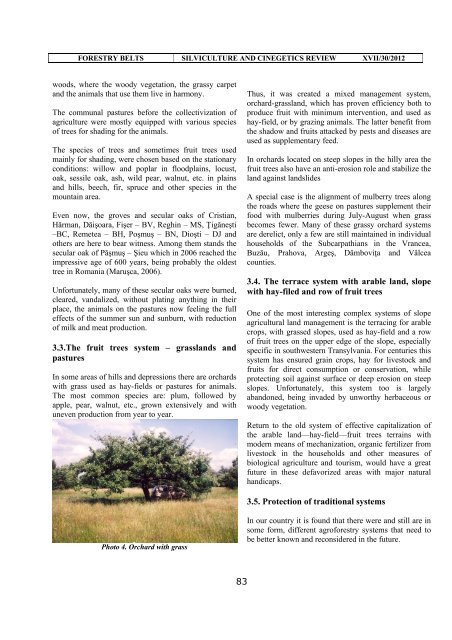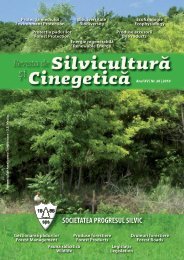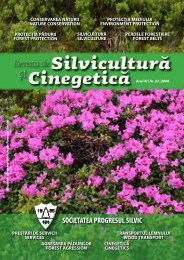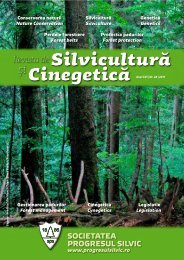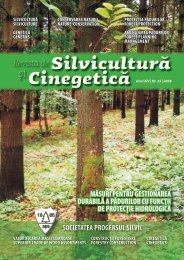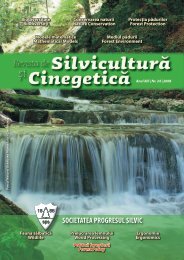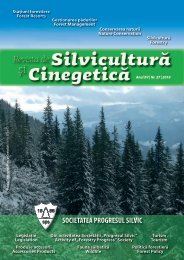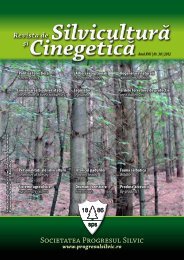Silviculture and Cinegetics Review - Societatea Progresul Silvic
Silviculture and Cinegetics Review - Societatea Progresul Silvic
Silviculture and Cinegetics Review - Societatea Progresul Silvic
You also want an ePaper? Increase the reach of your titles
YUMPU automatically turns print PDFs into web optimized ePapers that Google loves.
FORESTRY BELTS SILVICULTURE AND CINEGETICS REVIEW XVII/30/2012<br />
woods, where the woody vegetation, the grassy carpet<br />
<strong>and</strong> the animals that use them live in harmony.<br />
The communal pastures before the collectivization of<br />
agriculture were mostly equipped with various species<br />
of trees for shading for the animals.<br />
The species of trees <strong>and</strong> sometimes fruit trees used<br />
mainly for shading, were chosen based on the stationary<br />
conditions: willow <strong>and</strong> poplar in floodplains, locust,<br />
oak, sessile oak, ash, wild pear, walnut, etc. in plains<br />
<strong>and</strong> hills, beech, fir, spruce <strong>and</strong> other species in the<br />
mountain area.<br />
Even now, the groves <strong>and</strong> secular oaks of Cristian,<br />
Hărman, Dăişoara, Fişer – BV, Reghin – MS, Ţigăneşti<br />
–BC, Remetea – BH, Poşmuş – BN, Dioşti – DJ <strong>and</strong><br />
others are here to bear witness. Among them st<strong>and</strong>s the<br />
secular oak of Păşmuş – Şieu which in 2006 reached the<br />
impressive age of 600 years, being probably the oldest<br />
tree in Romania (Maruşca, 2006).<br />
Unfortunately, many of these secular oaks were burned,<br />
cleared, v<strong>and</strong>alized, without plating anything in their<br />
place, the animals on the pastures now feeling the full<br />
effects of the summer sun <strong>and</strong> sunburn, with reduction<br />
of milk <strong>and</strong> meat production.<br />
3.3.The fruit trees system – grassl<strong>and</strong>s <strong>and</strong><br />
pastures<br />
In some areas of hills <strong>and</strong> depressions there are orchards<br />
with grass used as hay-fields or pastures for animals.<br />
The most common species are: plum, followed by<br />
apple, pear, walnut, etc., grown extensively <strong>and</strong> with<br />
uneven production from year to year.<br />
Thus, it was created a mixed management system,<br />
orchard-grassl<strong>and</strong>, which has proven efficiency both to<br />
produce fruit with minimum intervention, <strong>and</strong> used as<br />
hay-field, or by grazing animals. The latter benefit from<br />
the shadow <strong>and</strong> fruits attacked by pests <strong>and</strong> diseases are<br />
used as supplementary feed.<br />
In orchards located on steep slopes in the hilly area the<br />
fruit trees also have an anti-erosion role <strong>and</strong> stabilize the<br />
l<strong>and</strong> against l<strong>and</strong>slides<br />
A special case is the alignment of mulberry trees along<br />
the roads where the geese on pastures supplement their<br />
food with mulberries during July-August when grass<br />
becomes fewer. Many of these grassy orchard systems<br />
are derelict, only a few are still maintained in individual<br />
households of the Subcarpathians in the Vrancea,<br />
Buzău, Prahova, Argeş, Dâmboviţa <strong>and</strong> Vâlcea<br />
counties.<br />
3.4. The terrace system with arable l<strong>and</strong>, slope<br />
with hay-filed <strong>and</strong> row of fruit trees<br />
One of the most interesting complex systems of slope<br />
agricultural l<strong>and</strong> management is the terracing for arable<br />
crops, with grassed slopes, used as hay-field <strong>and</strong> a row<br />
of fruit trees on the upper edge of the slope, especially<br />
specific in southwestern Transylvania. For centuries this<br />
system has ensured grain crops, hay for livestock <strong>and</strong><br />
fruits for direct consumption or conservation, while<br />
protecting soil against surface or deep erosion on steep<br />
slopes. Unfortunately, this system too is largely<br />
ab<strong>and</strong>oned, being invaded by unworthy herbaceous or<br />
woody vegetation.<br />
Return to the old system of effective capitalization of<br />
the arable l<strong>and</strong>—hay-field—fruit trees terrains with<br />
modern means of mechanization, organic fertilizer from<br />
livestock in the households <strong>and</strong> other measures of<br />
biological agriculture <strong>and</strong> tourism, would have a great<br />
future in these defavorized areas with major natural<br />
h<strong>and</strong>icaps.<br />
3.5. Protection of traditional systems<br />
Photo 4. Orchard with grass<br />
In our country it is found that there were <strong>and</strong> still are in<br />
some form, different agroforestry systems that need to<br />
be better known <strong>and</strong> reconsidered in the future.<br />
83


